|
By Charles Larry Nachusa Volunteer The sound of the sandhill crane seems to echo across an immense gulf of antiquity. Cranes evolved during the Eocene (56-33.9 million years ago). The earth was warmer and wetter during this time, and in North America, with vast areas of prairie, savanna, marsh, and shallow inland seas, it was ideal habitat for the ancient ancestors of modern cranes. This early crane was likely a relative of the crowned crane now found in Africa. Fossil remains of this early crane have been found in North America, dating some 10 million years. But then the climate in North America started to cool, eventually bringing about the Ice Ages. These events saw the disappearance of this early crane on the continent. At some point a relative of the modern crane, one suited for cooler climates, evolved here. The earliest fossil of this later crane was a bone almost identical to that found in modern sandhills. This fossil was found in Florida, dating back 2.5 million years. Modern sandhill cranes (Grus canadensis) are divided among two and six geographical subspecies, depending on sources. Generally, there are the greater and lesser sandhills. Nachusa Grasslands has had sandhill cranes stop over for brief periods over several years. In August of 2018, even a pair of whooping cranes stopped and then moved on! As far as is known, this is the first time that a pair of sandhills have nested and raised two colts (as the young sandhills are called) at Nachusa. It is usual for sandhill cranes to lay two eggs, a few days to a week apart, but it is rare that both colts will live to fledge. Some reasons as to why only one colt survives are various predators, lack of sufficient food, and sometimes the aggression of the older crane toward its slightly younger sibling. At Nachusa both of the young have fledged and are flying. Sandhill cranes usually mate for life. They become sexually mature at two years old but four or five years old is more likely to be when mating begins. Sandhills are well known for their "dancing" during mating season. This behavior is not fully understood, as cranes of any age may dance at times not related to breeding season. It is thought to also be a way of working off aggression. Both sexes participate in the building of the nest, constructed in or near water. Nests are composed of plant material found near the nesting site, such as cattails, sedges, rushes, and grasses. Nests can be six feet in diameter. At breeding time both sexes "paint" their feathers with clay and mud. The birds are normally gray in color, but the painting changes the feathers to brown. This is thought to be a camouflaging technique to blend in with the nesting site. Both parents incubate the eggs. While one sits on the nest, the other is either standing guard or gathering food. The female usually sits on the nest during the night. Hatching is about a month after laying. After hatching, the cranes abandon the nesting site, moving to a hidden spot somewhere still near water. The parents are fiercely protective of the young. Many predators are a danger to either the eggs or the colts. Among them are coyotes, foxes, raccoons, owls, and various hawks, all of which inhabit Nachusa Grasslands. Sandhills eat a variety of food, from insects such as grasshoppers or dragonflies, to aquatic plants and tubers, to small mammals such as mice, to snakes and worms. They will even eat the eggs of other birds, such as red-winged blackbirds, rails, and ducks. More recently, sandhills have learned to forage in cornfields and will often flock in vast numbers doing this. During breeding season, they are very territorial with an average territory range of about 20 acres. Until the cranes abandon the nesting site, where they are more or less isolated, they will defend this territory from other sandhills and predators by various aggressive displays and even fighting. By late summer the sandhills will probably move to an area where there is a larger crane population and more abundant food to fatten up for migration, which will happen sometime in the fall. The juveniles will stay with the parents during migration and through the winter. Sometime in the following spring they will separate from their parents and go out on their own. The main winter flyways for migration in this area are either south to Georgia or Florida or over to Texas. Sandhill cranes are threatened, as is true of cranes the world over. Climate change is one major threat. Droughts have become much more frequent, and wetlands are disappearing. In some states cranes are hunted. In the past, this resulted in the extinction of sandhills from Washington State in 1941. They have now been reintroduced to this state in small numbers. Farming conversion to incompatible crops (soybeans) over crops like corn also threatens cranes. Probably the biggest threat is from loss of habitat from urbanization and development. The sandhill crane is a magnificent bird. It would be tremendously sad if someday the sandhill crane were to join the thousands of species disappearing from our planet. To hear no more the sound of this bird, which author Peter Matthiessen says is "the most ancient of all birds, the oldest living bird species on earth." Sad indeed. Sources: Johnsgard, Paul A. A Chorus of Cranes: the Cranes of North America and the World. University of Colorado Press, 2015. Forsberg, Michael. On Ancient Wings. University of Nebraska Press, 2004. Matthiessen, Peter. The Birds of Heaven, North Point Press, 2001. Useful websites: If you would like to play a part in habitat restoration for sandhill cranes at Nachusa Grasslands, consider joining our Thursday or Saturday Workdays, or give a donation to the Friends of Nachusa Grasslands. Donations to Friends can be designated to support the ongoing stewardship at Nachusa.
12 Comments
By Erin Rowland Summer Science Extern 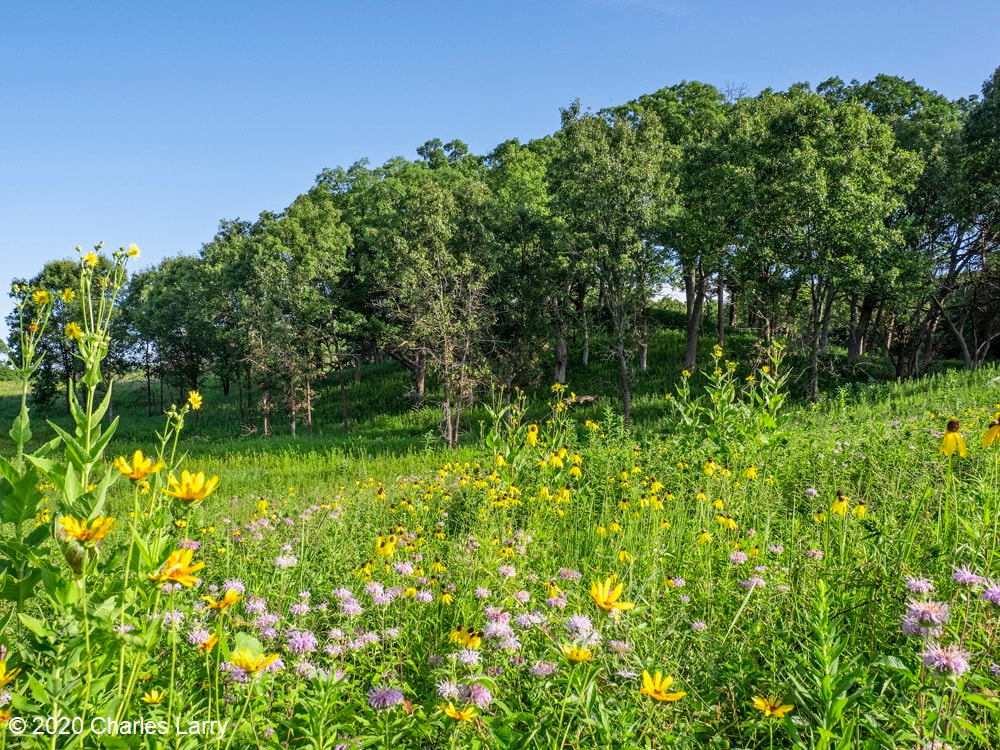 Picturesque restorations like this are made possible by the work of volunteers and stewards on the ground. Science provides a new lens to better understand the impacts of this work. When I think of prairie restoration, I tend to think of the hands-on. I picture crews of volunteers collecting buckets of seed, or the summer crew fanned out in a line spraying weeds. Even the science done at Nachusa tends to conjure images of researchers trekking through the tallgrass after Blanding’s turtles, rodents, or butterflies. When I pictured my summer as Nachusa’s summer science extern, these were the images that filled my head. I couldn’t wait to spend my weeks under the sun trapping small mammals and surveying plant diversity. Meanwhile, the universe had other plans. Because of the COVID-19 pandemic, research looked a little different this year. Many field scientists were able to conduct safe and socially distant work, while some researchers had to cancel their field seasons altogether. I was one of the unlucky ones. Instead of a summer in the field, I spent the summer at a computer. The funny thing is, this turn of events helped me to see the big picture. Geographic Information Systems (GIS) is a broad category of science that combines geography with other disciplines to create smart maps and analyze data throughout space and time. It’s a booming field, and it touches every aspect of our lives, whether we see it or not. GIS is used in everything from urban planning to public health to ecology. It allows us to ask and answer really interesting questions such as how the arrangement of land patches and proximity to different types of cover impact everything else on the preserve. This summer, I spent my time looking at the preserve from above in aerial imagery, trying to understand how all the pieces fit together. I spent a lot of my time converting old images of prescribed burn locations into a digital format, a process that feels a lot like a small child playing connect-the-dots. Tedious as it may be, this labor of love will help us see patterns through time in a new way. We can now easily ask how frequently certain areas of the preserve are burned and what that might mean for the plants and animals who live there. 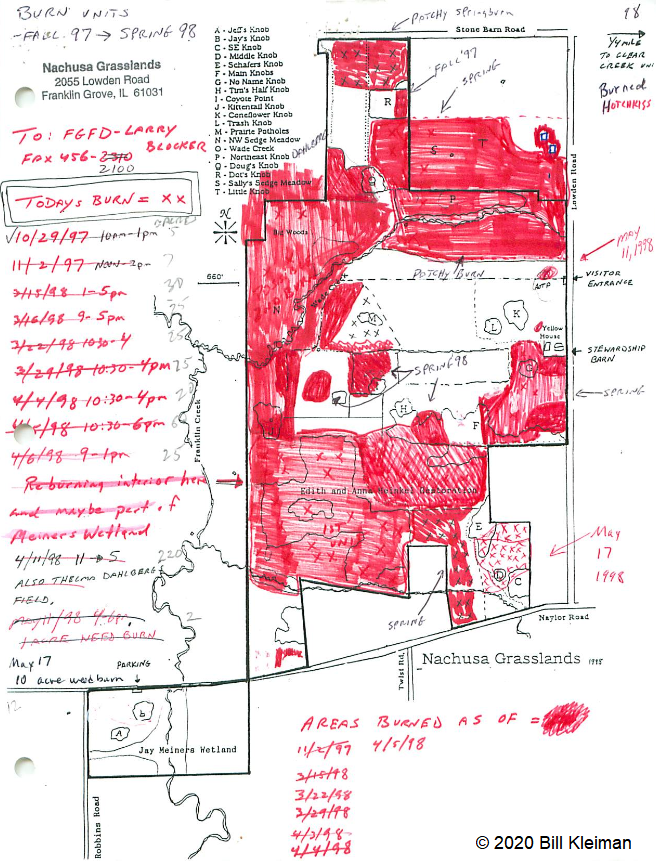 Historically, records of prescribed burns were hand-drawn and not very precise. Our new digital fire maps are uniform and standardized, which will improve our ability to use the information. The second aspect of my work this summer was a bit more practical. Collaboration is one of the most valuable components of research at Nachusa Grasslands, and it’s part of what makes me so excited about working there. There’s such great diversity in the projects at Nachusa, as you can clearly see from the spectrum of projects funded by the Friends of Nachusa Grasslands science grants. One of my goals this summer was to compile a map of all the long-term research sites on the preserve, as well as to describe the types of data collected on these plots. By making information about data more broadly accessible, we can support better science that can benefit Nachusa and other prairie restoration sites. Researchers are better able to collaborate if they know what data exists and to whom to talk about it. 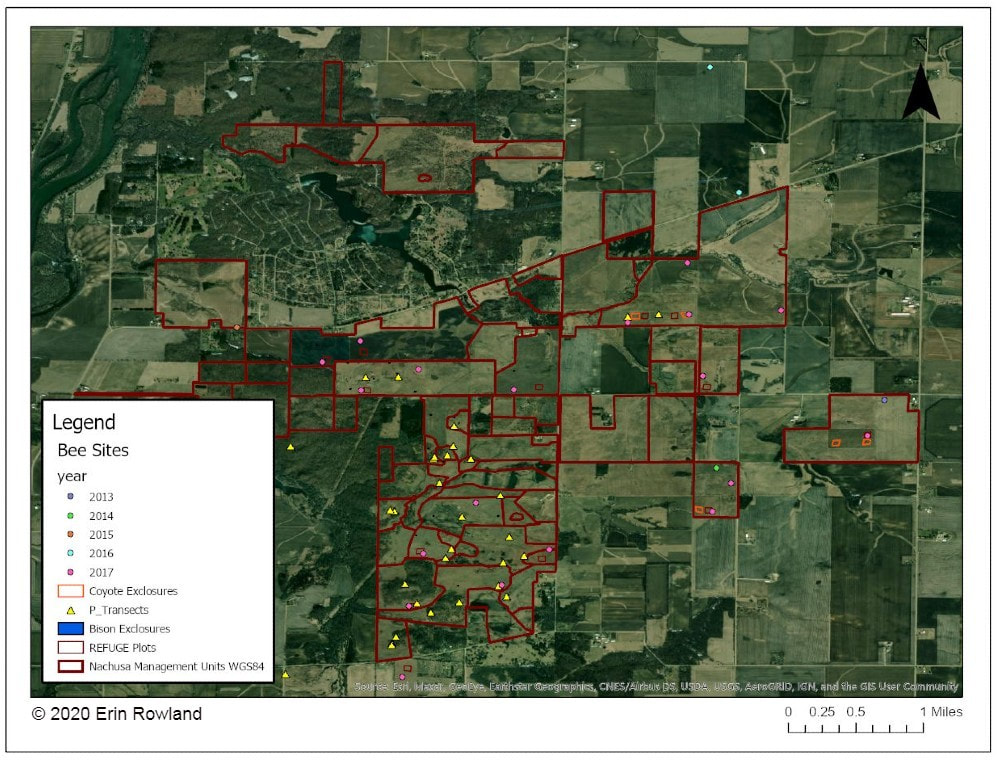 A map of long-term research sites at Nachusa will help researchers to more effectively collaborate and establish new projects more easily. The third part of my work this summer was beginning to understand the impact of human-made boundaries on a natural system. Plants and animals don’t care at all about the arbitrary places we draw our lines on a landscape. A piece of habitat is all the same to them, regardless of who owns it. This means that we have to be aware of the places where we create borders and boundaries and understand the impacts that they may have. A simple mowed path for a stewardship vehicle may seem minor to us, but might represent an insurmountable obstacle to a vole. One of the most exciting revelations of my work this summer is a success story in the tallgrass. I conducted analysis to understand how insulated different areas of the preserve are from the surrounding landscape. I created a heatmap to illustrate distance from the edge of the preserve, an attempt to classify land by how far it is from the proverbial “edge.” The results showed that the best-insulated area of the preserve is part of the original purchase that established Nachusa Grasslands. Not only was a beautiful portion of remnant prairie preserved, but the land around it was converted to create a pure prairie landscape with a buffer of protection from the surrounding agriculture and development. 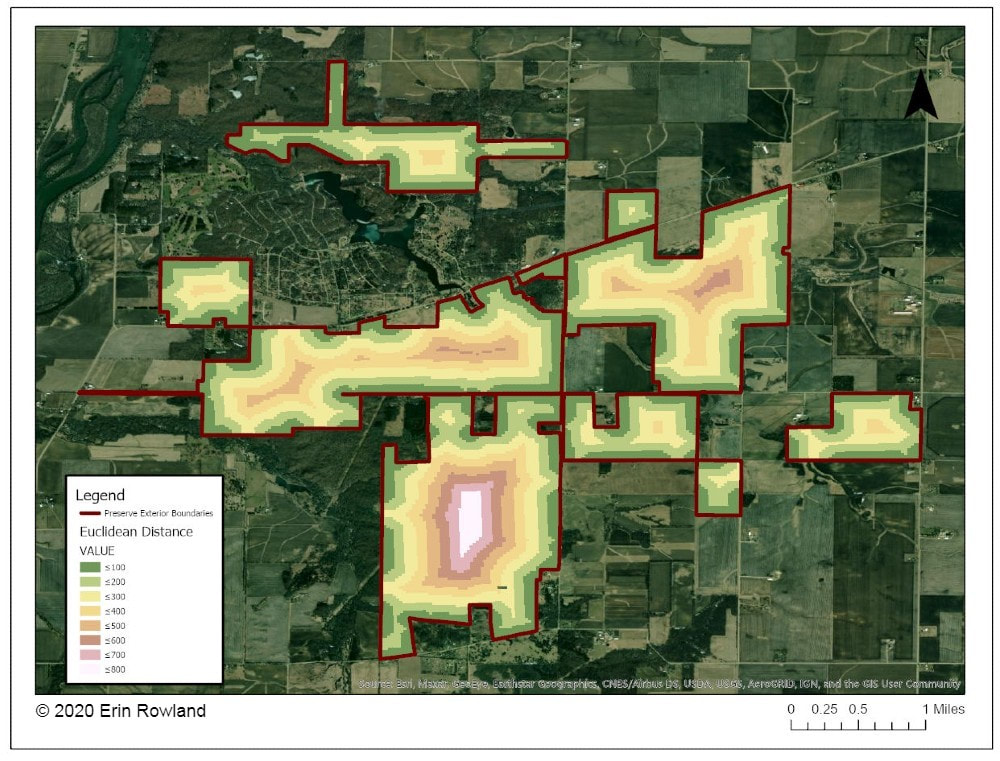 This map helps us to understand how close various areas of the preserve are to non-prairie edge. We can see which areas are the most insulated from external impacts. Management happens at a variety of scales. Many decisions are made at the smallest scale: an invasive species can be removed from a part of a unit, and seeds can be collected from a rich patch of big bluestem to be planted next year. What’s harder to consider is how these seemingly small decisions work in tandem to create larger-scale impacts. The preserve looks different from above than it does on the ground. The challenge for managers is to be able to simultaneously see the prairie and the plants, as well as the forest and the trees. To meet the needs of a prairie restoration, one has to imagine the view of a turtle or a ground squirrel, in order to imagine a patch of grass as your whole world. At the same time, one must consider the big picture. Making decisions on the small-scale for the sake of specific animals or desirable plants can negatively impact the overall health of a system. What excites me the most as a researcher at Nachusa is the opportunity to do science that helps us make better decisions in restoration. By taking a step back out of the grass this summer, I had the chance to look at the preserve from a different perspective. I gained a new appreciation for the complexity of a prairie restoration project and the multi-faceted decision-making with which land managers are tasked. Now I look forward to taking my maps and figures and using them to ask more questions about how our work changes the landscape and how the landscape changes our work. Erin Rowland's ongoing research on small mammals and landscape ecology is supported with a Scientific Research Grant from the Friends of Nachusa Grasslands. The Nachusa summer science externship is supported by The Nature Conservancy. To get involved withe the critical on-the-ground work at Nachusa, consider joining our Thursday or Saturday Workdays or giving a donation to the Friends of Nachusa Grasslands. Donations to Friends can be designated to Scientific Research Grants. If you are interested in learning more about Erin's small mammal work, check out the recent blog by Jessica Fliginger or contact Erin to learn about opportunities to volunteer!
By Chandler Dolan Bumble Bee Technician Introduction The scene: It’s a classically humid, July afternoon. A gaze across the prairie shows patches of yellows and pinks, suggesting the presence of yellow coneflower and wild bergamot. As the heat intensifies, the birds and bison seem to slow. You stand quietly, intently listening to the sounds the grassland offers. Suddenly, a loud buzz tears through the patterns of bird melodies and katydid song. A familiar yellow and black face emerges from under a canopy of partridge pea: a bumble bee. Bumble bees are familiar insects. The shaggy combination of yellow and black (and sometimes orange) hairs with a plump, round build makes these insects nearly unmistakable. Their role of pollinating beautiful wildflowers and food plants alike is an important ecosystem service they provide us, free of charge. Their friendly buzz and frantic foraging suggest a healthy ecological system. Unfortunately, bumble bees face an uncertain future. Through habitat loss, pesticide use, and disease, many bumble species have experienced significant decline and are becoming increasingly rare. Thankfully, Nachusa gives refuge to three threatened species of bumble bees, including the critically endangered rusty-patched bumble bee (Bombus affinis). In 2017, Bethanne Bruninga-Socolar discovered the presence of the rare bumble bee at Nachusa in the form of a foraging worker. This was a great discovery, as the current distribution of the species is fairly unknown. To know this species was living at Nachusa was special and has given rise to new research opportunities and questions to be answered. With the new motivation of a federally endangered species in the Grasslands, new projects have begun! The 2020 season is the first season we have boots on the ground (in the form of me!) to monitor bumble bee abundance and diversity across all species of bumble bee at Nachusa. We start with simple questions: What species of bumble bees are here? How many of them are there? What flowers are they using? By answering these questions, we can start to form new questions and learn about the Grasslands. This season is all about exploration, experimentation, and just getting a sense of the bumble bees at Nachusa. Endangered Bumble Bees of Nachusa Grasslands As mentioned, the rusty-patched bumble bee is a federally recognized endangered species in the United States. In fact, it is the first bumble bee species to be listed on the United States Endangered Species Act. This characteristic bumble bee sports a unique “rusty patch” on its abdomen, which is one of its best identification traits, hence the name. The decline of this species is somewhat mysterious and very sudden. Prior to 1996, this species was abundant throughout much of the Midwest and Northeastern U.S. After 1996, the species tumbled into rapid decline and is now extremely rare in the Northeast. Most records of this species today are sporadically reported in the Midwest, but at very low rates. In the seven weeks I have been surveying, I have detected two rusty-patched bumble bee workers at Nachusa. To know this species is still present and not extinct is a great discovery alone. But understanding the way it uses the mosaic and where it chooses to nest is still up for question, and is difficult to answer with such sparse sightings. Our first sighting occurred very early in the field season. In fact, it was the fourth day of surveying! Seeing a single rusty-patched worker busily foraging on beardtongue (Penstemon digitalis) was a great way to start the season. Our second was about a month later on July 17th. Upon my arrival to a hill to do some quick exploration, the very first bee I spotted was the rare but distinct bumble bee methodically feeding on wild bergamot (Monarda fistulosa). I held back tears of joy as I quickly netted the bee for proper identification. Nachusa also houses two other declining bumble bee species: the golden yellow bumble bee (Bombus fervidus) and the American bumble bee (Bombus pensylvanicus). Bombus fervidus has quickly become one of my favorite species, as its striking yellow abdomen and bold, black thorax band are impossible to miss. While these species are not recognized as endangered by the federal government, they have documented declines that warrant them a “vulnerable to extinction” assessment by the IUCN Redlist. I’m happy to report that these species are detected regularly and seem to like certain parts of the Grasslands. One day we hope to answer these questions: What parts of Nachusa are these vulnerable species found, and why? What makes one patch of habitat more suitable than another? Conclusion Bumble bees are interesting. Their familiarity provides a calming energy, as their small wings effortlessly lift their seemingly oversized bodies and loads of pollen to provide for the nest and its offspring. But despite how recognizable they may be, there is still much to learn about them. Simple things such as their habitat and favorite flowers are yet to be fully understood. A closer look into the world of bumble bees reveals a world of individual decision-making by our hairy friends that we are working hard to better understand. One of the first steps to conserving a species is to better our understanding of them. With the first long-term bumble bee surveying season at Nachusa underway, we hope to better understand our bumble bees and to one day provide them the best habitat we can. To lose a species is to lose a piece of a puzzle. Once gone, the picture will never be the same, with a hole no other piece can fill. *** UPDATE: On July 29th and 30th, two more rusty-patched bumble bees were observed at Nachusa! That makes a total of 4 observations this season! *** Dr. Bethanne Bruninga-Socolar's ongoing research on Nachusa's bumble bees is supported with a Scientific Research Grant from the Friends of Nachusa Grasslands. If you would like to play a part in helping the bees at Nachusa Grasslands, consider joining our Thursday or Saturday Workdays or giving a donation to the Friends of Nachusa Grasslands. Donations to Friends can be designated to Scientific Research Grants. Chandler Dolan graduated from the University of Northern Iowa in December of 2019. Throughout Chandler's career as a young biologist, they have been continually drawn to endangered species ranging from the rusty-patched bumble bee to neotropical parrots and migratory songbirds. As Chandler dives deeper into the world of bumble bees, they hope to pursue bumble bee conservation as a long-term goal for graduate school.
|
Blog CoordinatorDee Hudson
I am a nature photographer, a freelance graphic designer, and steward at Nachusa's Thelma Carpenter Prairie. I have taken photos for Nachusa since 2012. EditorJames Higby
I have been a high school French teacher, registered piano technician, and librarian. In retirement I am a volunteer historian at Lee County Historical and Genealogical Society. Categories
All
Archives
January 2024
|
CONNECT WITH US |
|
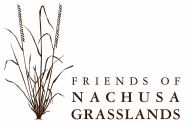
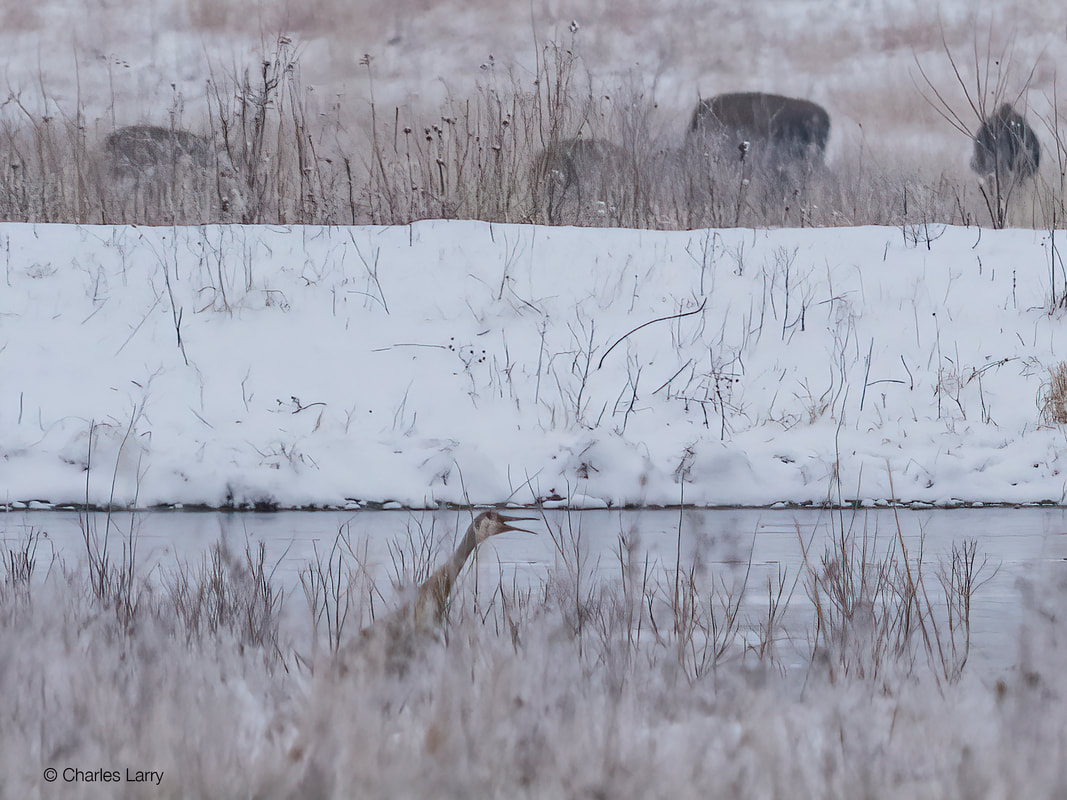
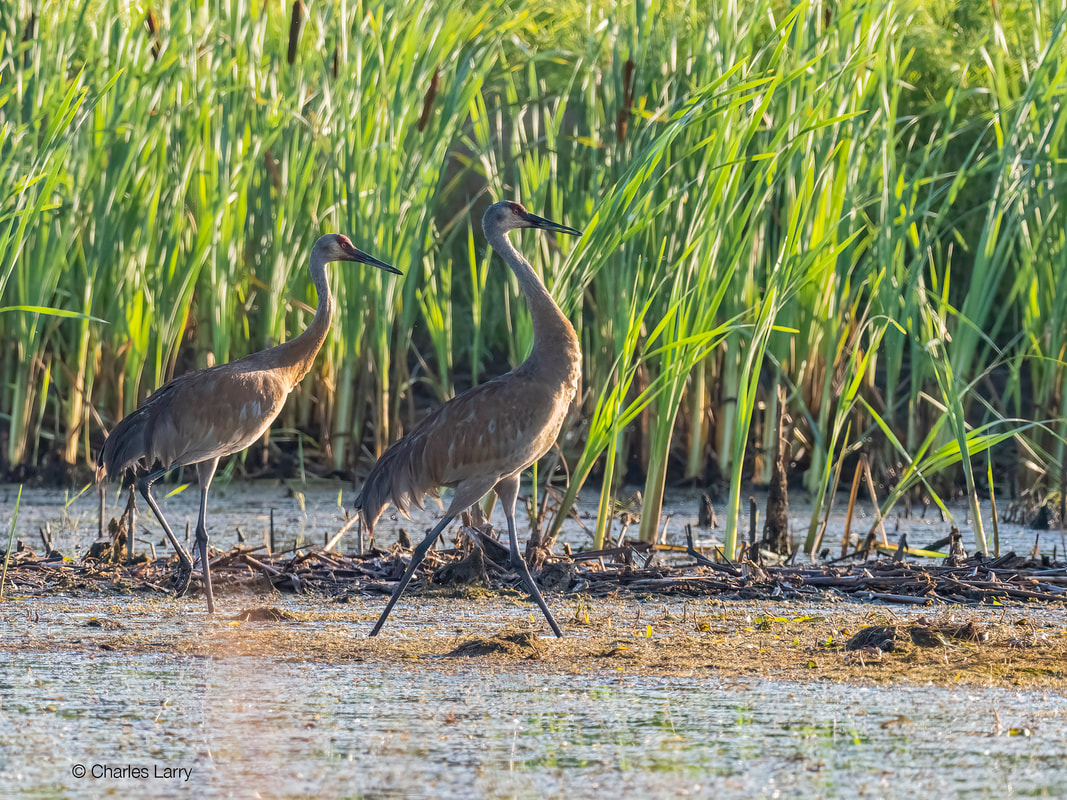
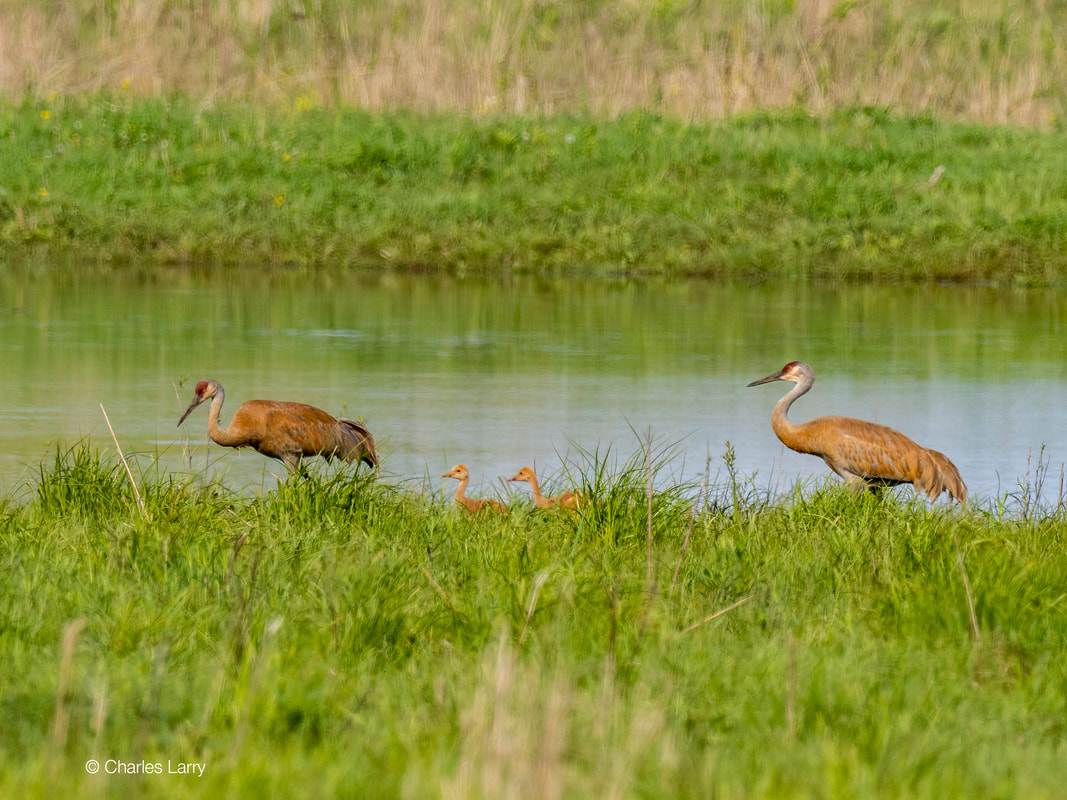
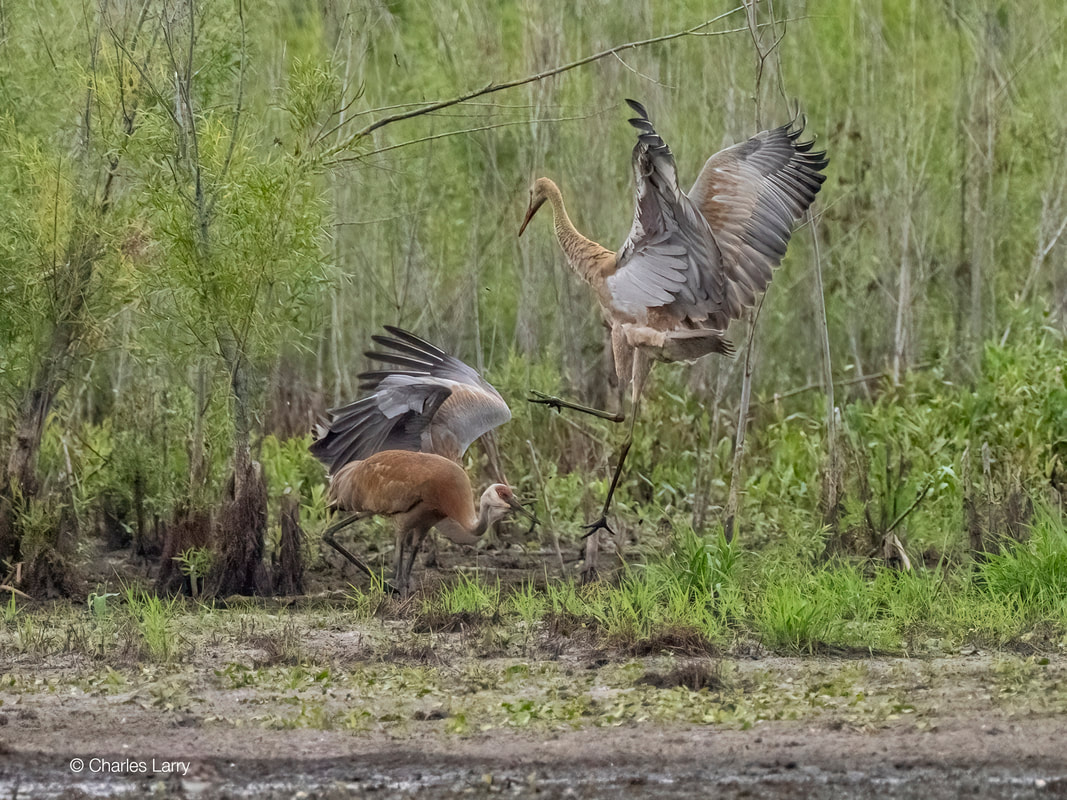
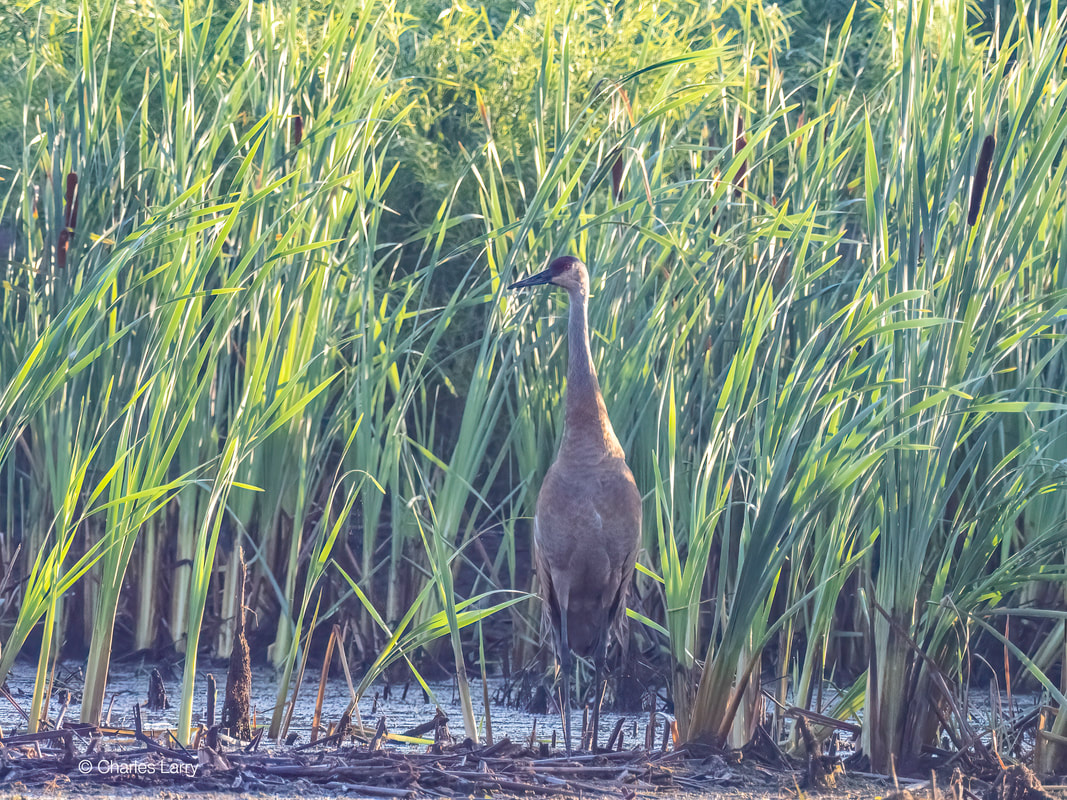
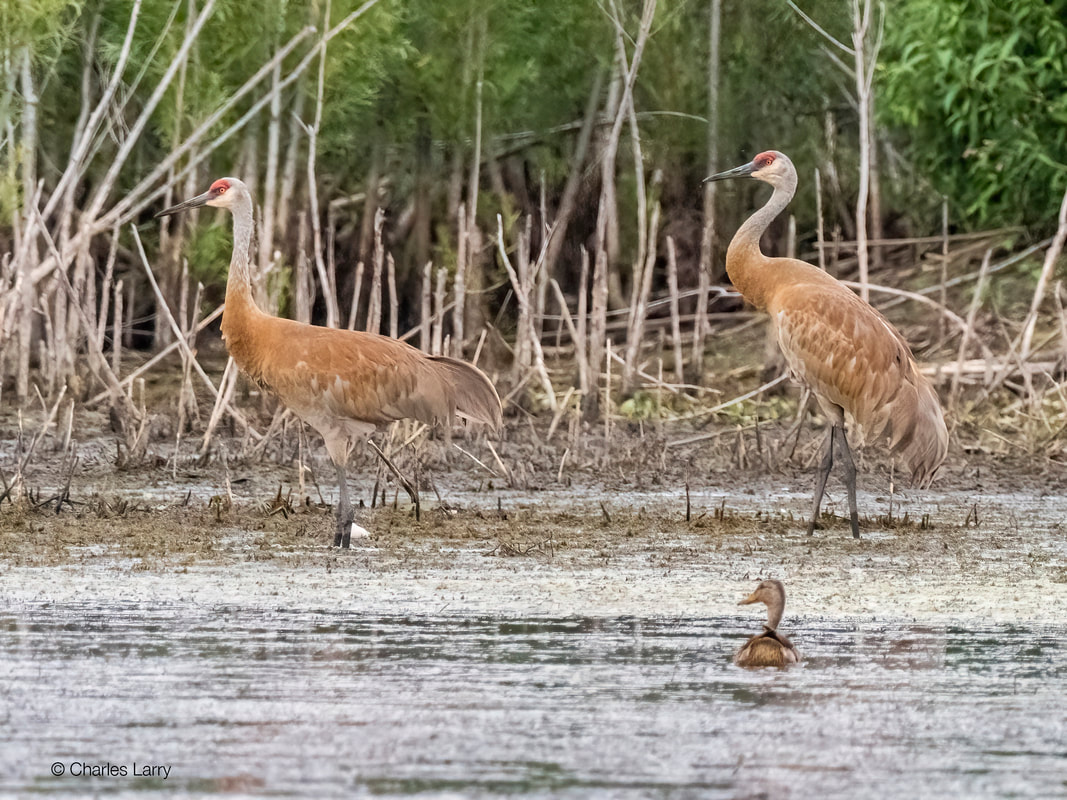
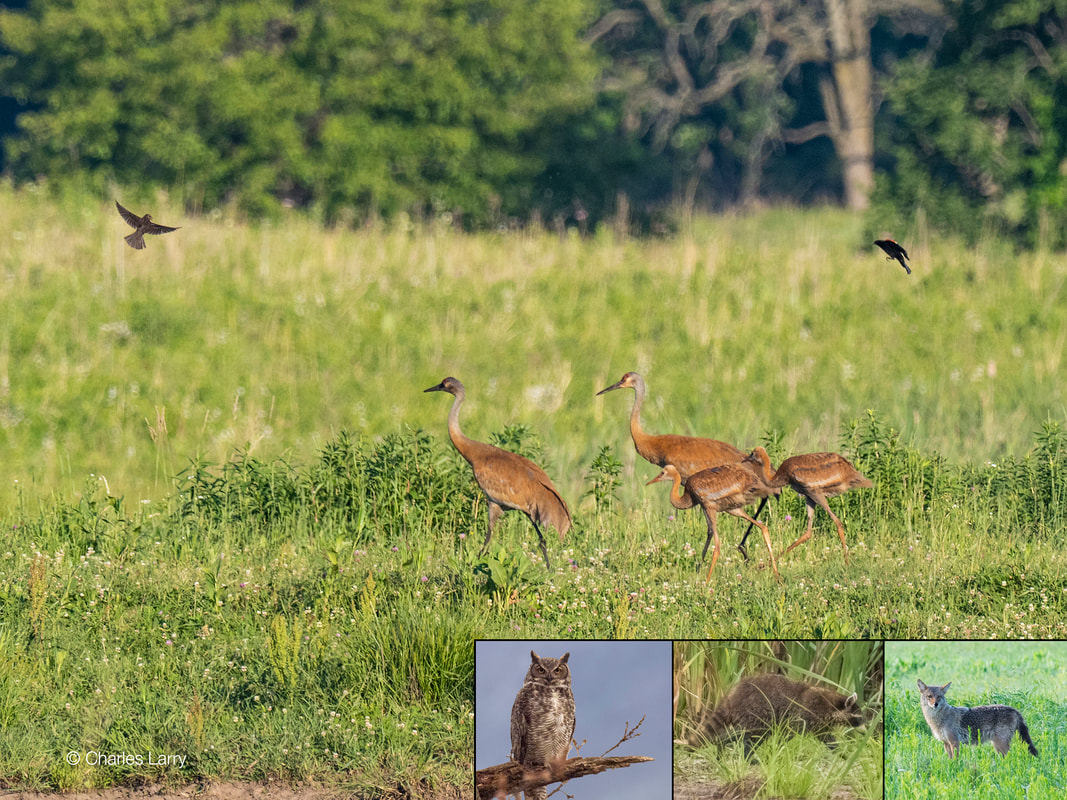
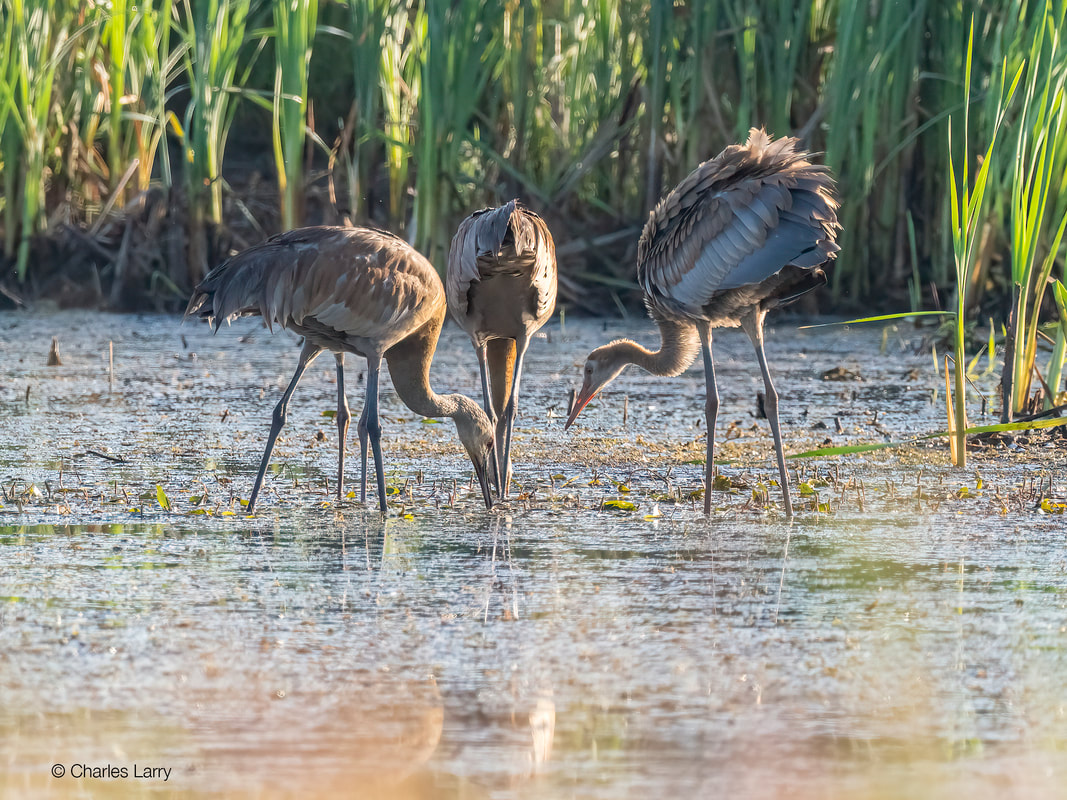
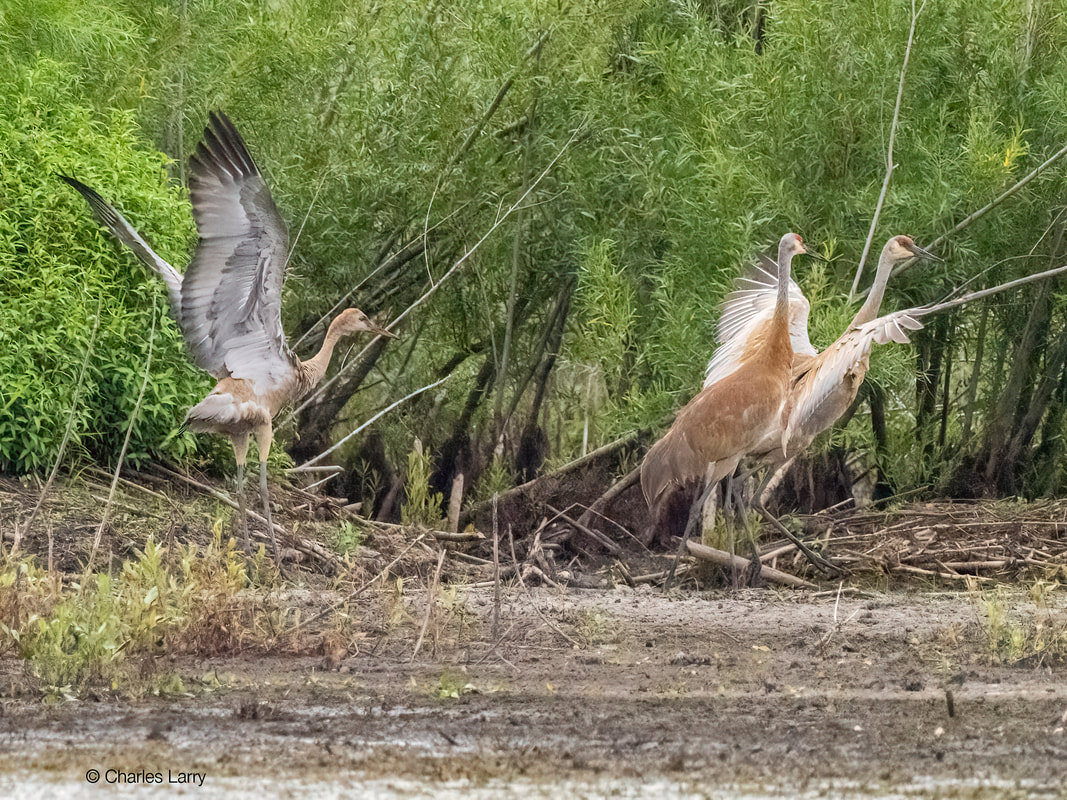
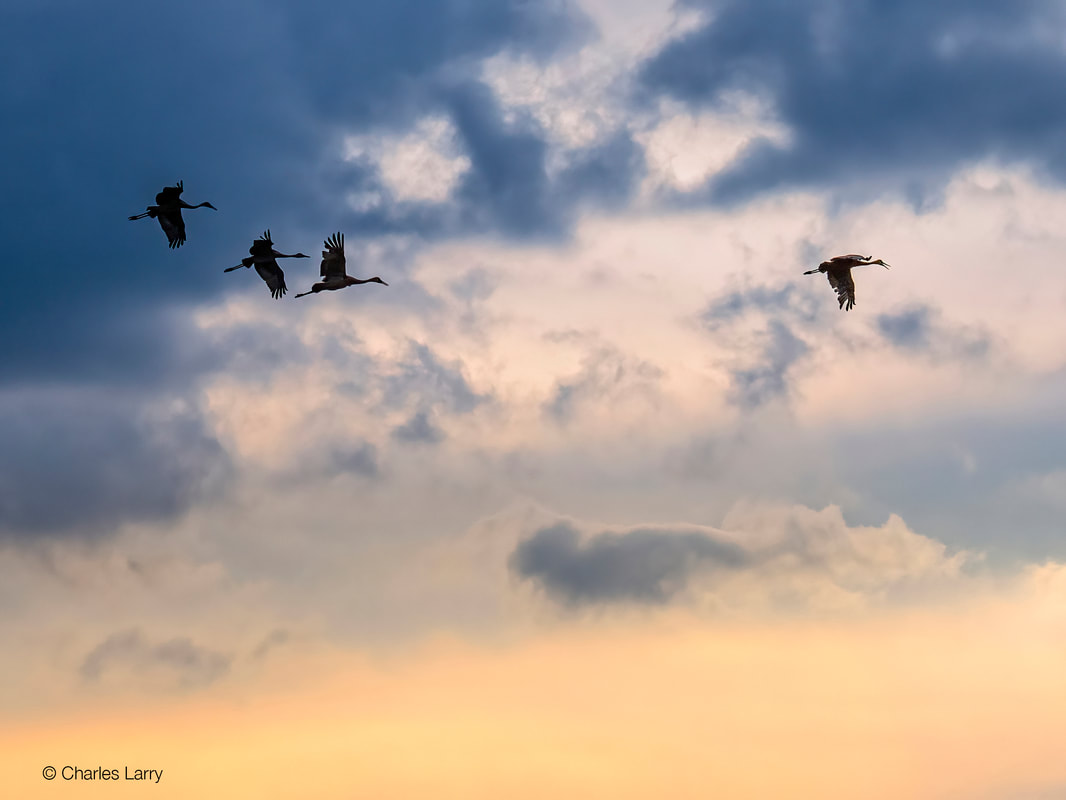

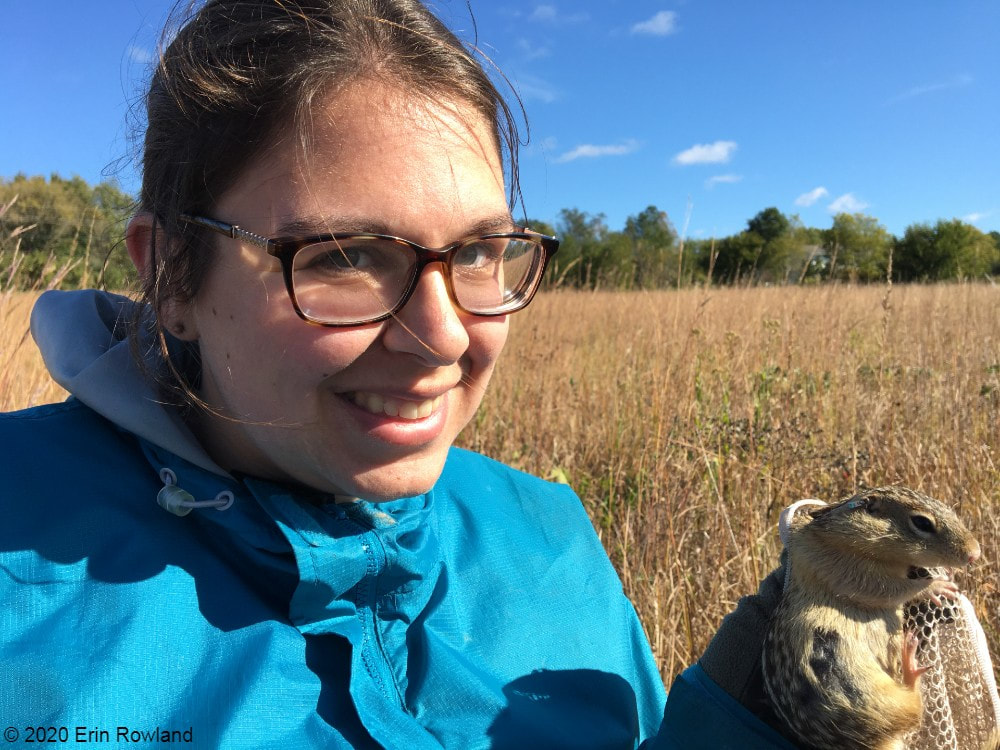
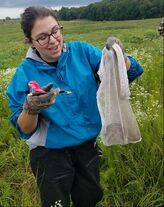
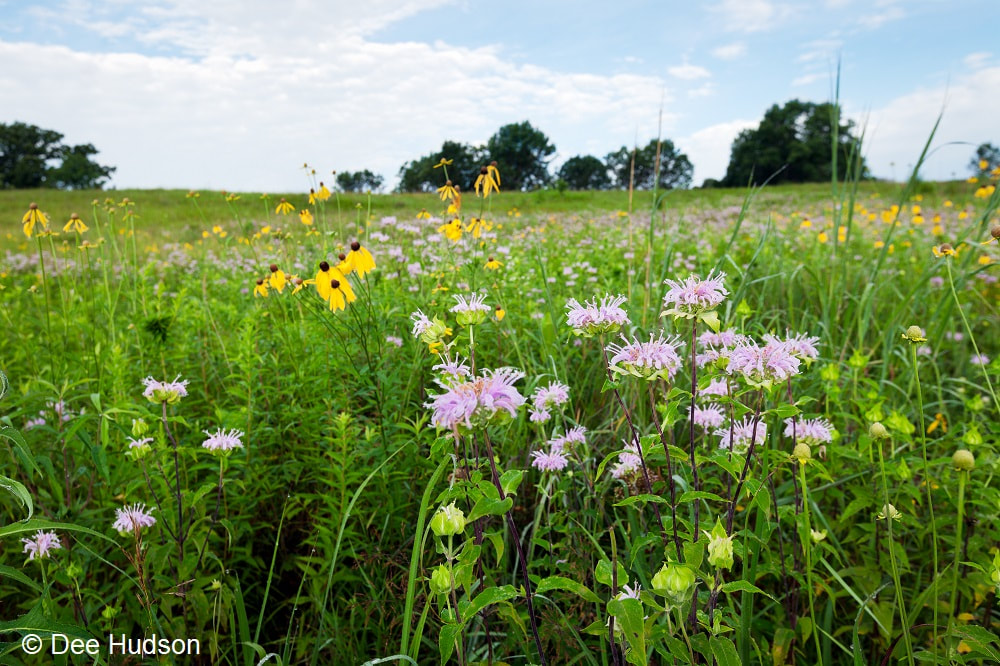
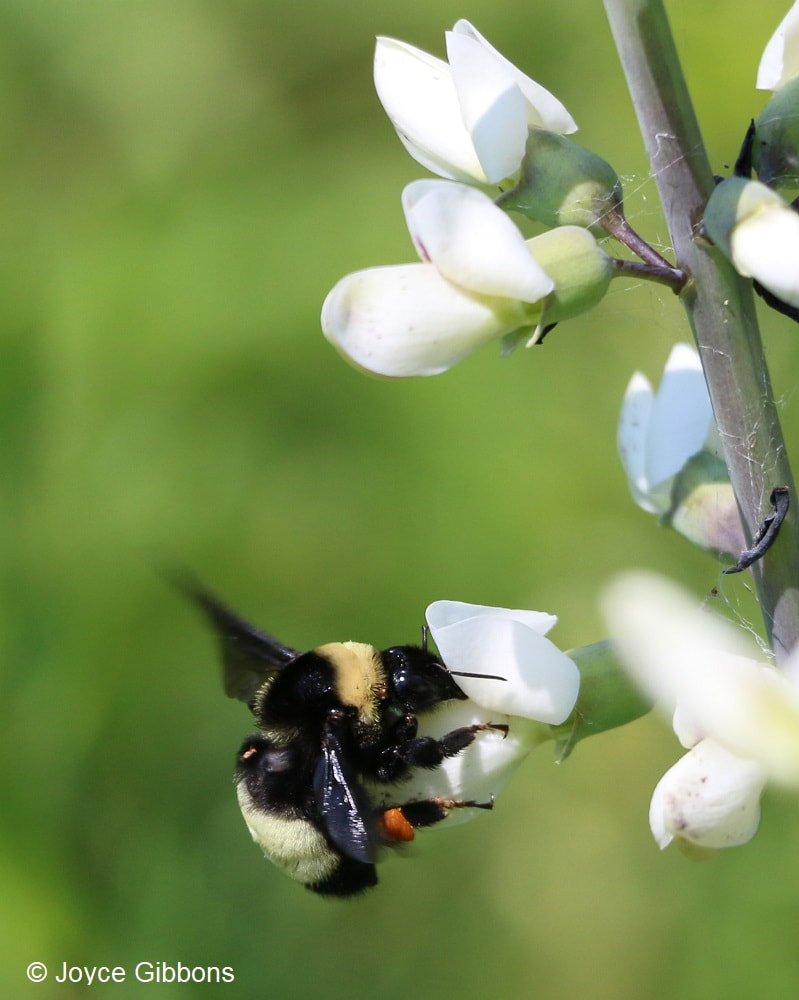
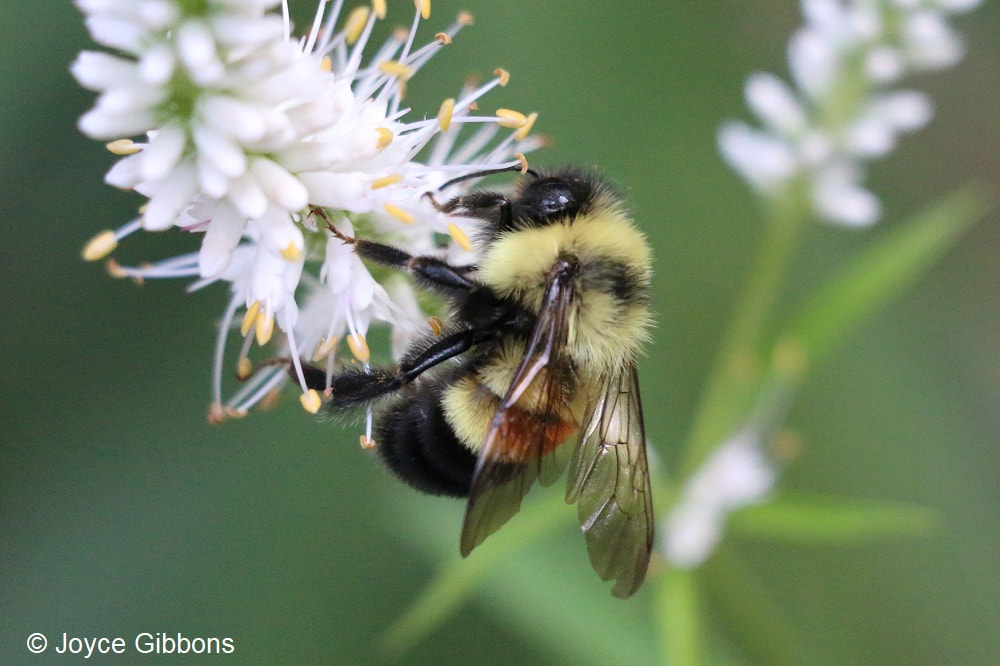
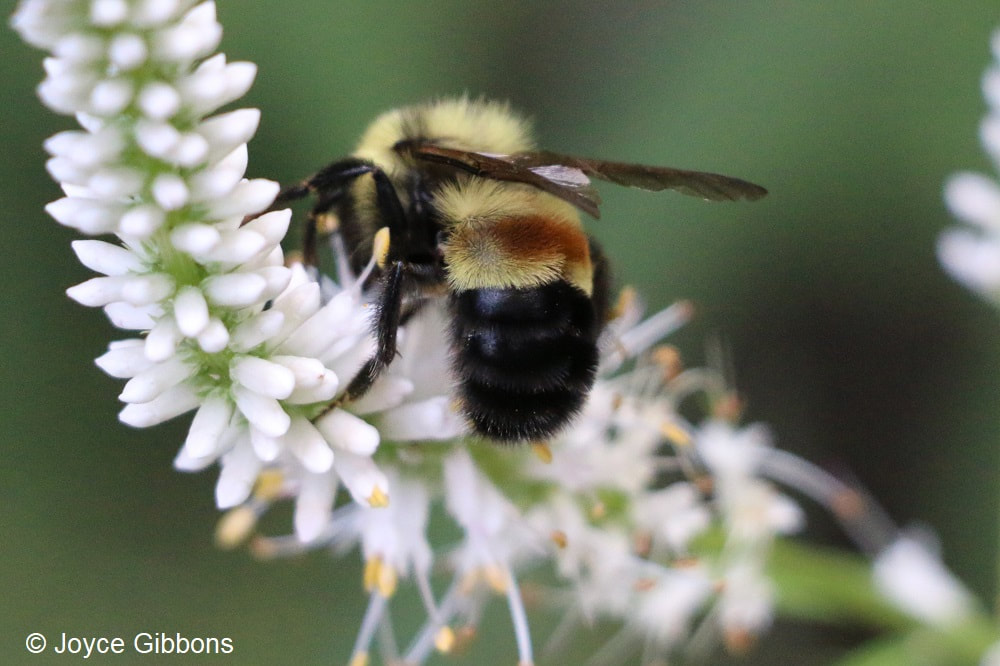
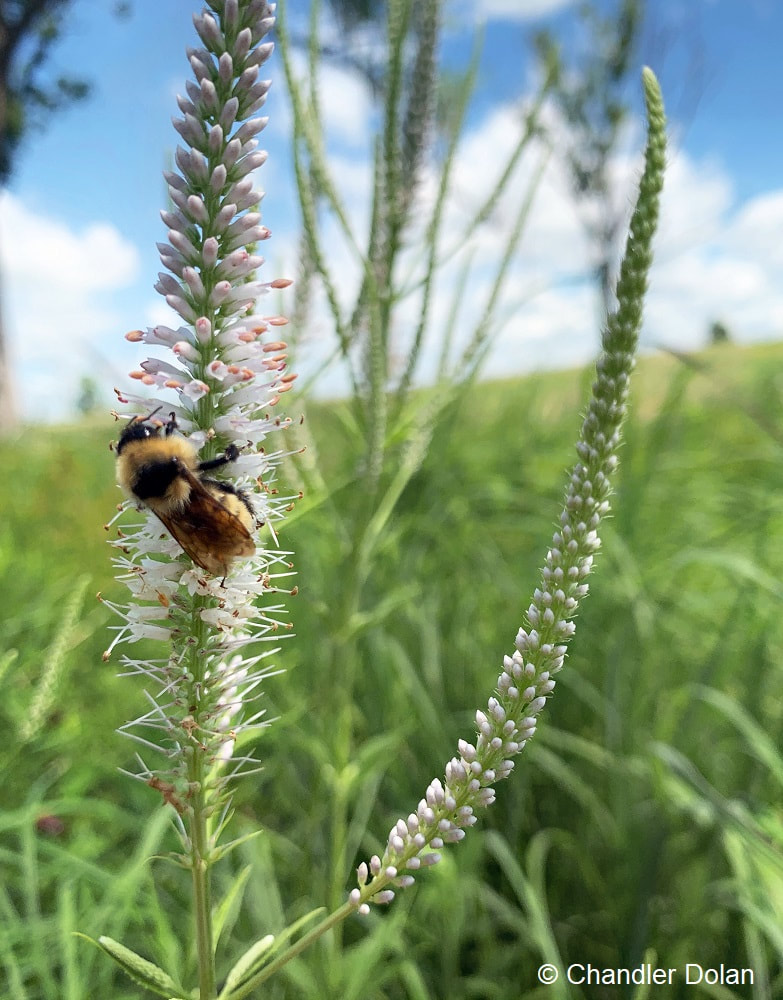
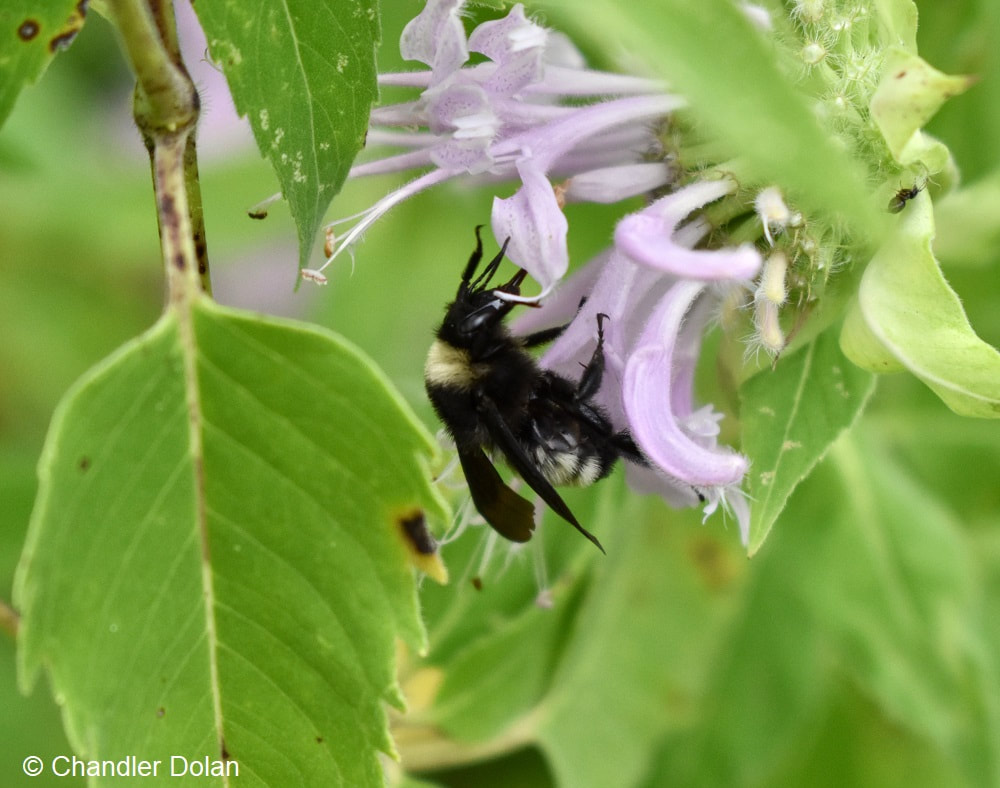
 RSS Feed
RSS Feed